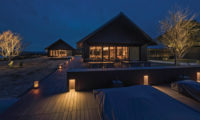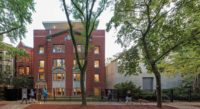Dedicated to the goddess Amaterasu, Japan's highest Shinto deity, the country's two most sacred sites are the Naiku and the Geku sanctuaries within the Grand Shrine complex at Ise, in the Mie prefecture. Every 20 years, the simple wooden structures supported by wood columns and topped by thatched roofs, undergo a ritual reconstruction. Each of the two buildings is dismantled and erected anew on an adjacent site by highly specialized carpenters. Though this cycle has been going on for centuries, the individual shrines are so revered that they are kept under wraps, leaving most people unaware about what actually takes place. To shed light on the secretive ceremony, known as Sengu, shrine officials commissioned the Tokyo architect Akira Kuryu to design an Ise Shrine Sengu museum where, for the first time, visitors are able to view large-scale models of and artifacts salvaged from the buildings. Because he needed good lighting to accentuate the displays, Kuryu turned to the Tokyo-based Lighting Planners Associates (LPA).
Kuryu's L-shaped building is located near the entrance to the Geku (or outer) precinct and hugs an iris-studded pond. One leg contains a glazed rest pavilion, the other the museum, a single-story sequence of symmetrically organized spaces crowned by a massive pitched roof made of cast iron.
PeopleFormal name of building: Sengukan Museum
Location: Ise City, Mie Prefecture
Completion date: 2012
Gross square footage: 16,062sqm (site area) 1,969sqm (building area) 2,622sqm (floor area)
Total project cost: withheld
Total construction cost: withheld
Client: Jingu Shikinen Zoueicho
Owner: Jingu Shikinen Zoueicho
Architect's firm name: A. Kuryu Architect & Associates
Architect of record: Tatsuo Iwasa
Engineers: Katsuo Nakata Engineering
Consultant(s): Landscape: Placemedia Landscape Architects Collaborative, Shunsaku Miyagi Lighting: Lighting Planners Associates, Kaoru Mende, Mari Kubota, Tsutomo Nagatsu(*former staff)
General contractor: Taisei Corporation
Photographer(s): Toshio Kaneko
Lighting designer: Lighting Planners Associates — Kaoru Mende, Mari Kubota, Tsutomo Nagatsu
Size: 21,200 square feet
Cost: withheld
Completion date: 2012 |
ProductsStructural system List type, e.g. concrete or steel frame, wood, etc.: reinforced concrete, steel frame
Lighting Interior ambient lighting: Yamagiwa, DN Lighting, TOKI
Other unique products that contribute to sustainability Photo sensor
Membrane Nittobo |









Post a comment to this article
Report Abusive Comment